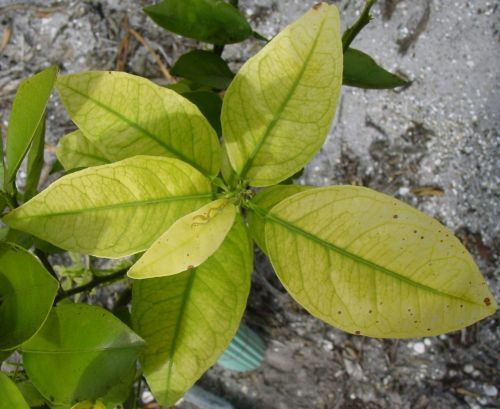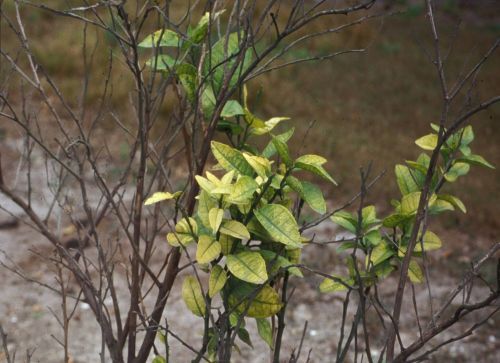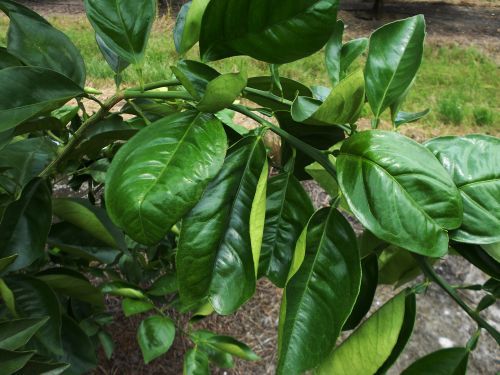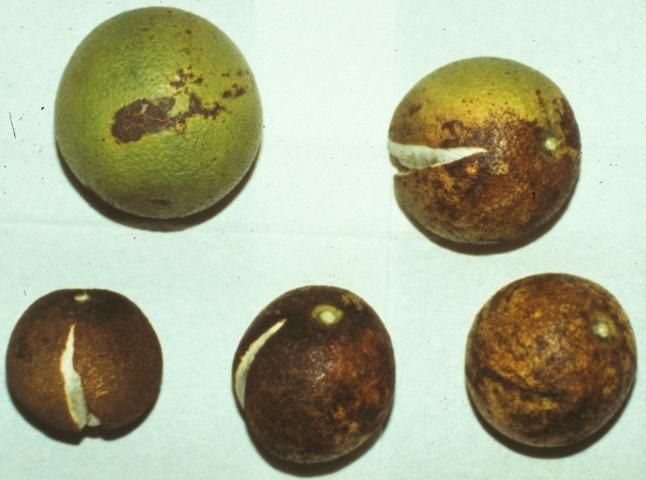This publication is part of a series about understanding nutrient requirements for citrus trees. For the rest of the series, visit https://edis.ifas.ufl.edu/topic_series_citrus_tree_nutrients.
To maintain a viable citrus industry, Florida growers must consistently and economically produce large, high-quality fruit crops year after year. Efficiently producing maximum yields of high-quality fruit is difficult without understanding soil and nutrient requirements of bearing citrus trees. Most Florida citrus is grown on soils inherently low in fertility with low-cation exchange capacity (CEC) and low water-holding capacity; thus, soils are unable to retain sufficient quantities of available plant nutrients against leaching caused by rainfall or excessive irrigation.
Seventeen elements are considered necessary for the growth of green plants:
- Carbon (C)
- Hydrogen (H)
- Oxygen (O)
- Nitrogen (N)
- Phosphorus (P)
- Potassium (K)
- Magnesium (Mg)
- Calcium (Ca)
- Sulfur (S)
- Manganese (Mn)
- Zinc (Zn)
- Iron (Fe)
- Copper (Cu)
- Boron (B)
- Chlorine (Cl)
- Molybdenum (Mo)
- Nickel (Ni)
Plants obtain C, H, and O from carbon dioxide and water. The remaining elements, which are called the "mineral nutrients," are obtained from the soil. Mineral nutrients are classified as macronutrients and micronutrients. The term "macronutrients" refers to those elements that plants require in large amounts (N, P, K, Mg, Ca, and S). The term "micronutrients" applies to plant nutrients that are essential to plants but are needed only in small amounts (Mn, Zn, Fe, Cu, B, Cl, Mo, and Ni).
When macronutrients are supplied in relatively high proportions to micronutrients for growth stimulation of newly planted citrus trees, extreme depletion of micronutrients can develop as a result of marked top growth, and micronutrient deficiencies can appear. Therefore, a balance between macronutrients and micronutrients is needed. Citrus micronutrient deficiencies are most commonly observed on previously uncultivated soils, shallow soils with high water table, extremely sandy areas, and calcareous soils.
Since mineral nutrition is a major factor in maximizing yield of high-quality fruit, understanding the functions of mineral elements, diagnosing nutrient deficiencies, and providing needed fertilizers are essential. This publication describes and discusses iron (Fe) and copper (Cu) deficiencies, functions, and recommended practices to alleviate nutritional problems.
Introduction
Meeting the world's escalating food needs cannot be achieved without fertilizer input. Without fertilizer, the world would produce only about half as much food, and more forested and marginal lands would have to be put into production. Inorganic commercial fertilizer plays a critical role in the world's food security, and it is important from both yield and food quality perspectives. Intensifying production and increasing yield on limited arable land secures a sufficient food supply, and fertilizer plays a critical role in these goals. Intensifying production is increasingly essential to meet the challenge of future food demands. However, this intensification must be done while also minimizing environmental impacts. The 4R Nutrient Stewardship Framework (i.e., right fertilizer source, right rate, right time, and right place) is therefore very important.
Iron and Copper Deficiencies
Iron Deficiency
Iron deficiency is common on calcareous soils. A calcareous soil contains a high concentration of calcium carbonate and has a pH of about 8.3. These soils may contain appreciable amounts of Fe, but it exists in a form that is only slightly available to plants. Iron deficiency can also be attributed to low soil Fe concentration in white sandy areas near lakes or ponds and in places known locally as "sand-soaked areas." Iron deficiency can be induced by high phosphorus (P) or accumulation of heavy metals, primarily Cu, in the soil. Iron deficiency is commonly associated with zinc (Zn) and manganese (Mn) deficiencies.
The symptom of Fe deficiency is known as "iron chlorosis" and is called "lime-induced chlorosis" when it occurs on calcareous soils. Deficiency symptoms occur on young leaves, which appear a light yellow to white in color, with the veins greener than the remainder of the leaf (Figure1). In acute cases, the leaves are reduced in size, and they are fragile, very thin, and can shed early. The trees die back severely on the periphery and especially at the top (Figure 2). Some trees may have a dead top with the lower limbs carrying almost normal foliage. Eventually, tree canopy volume decreases and fruit set and yield are reduced. The fruits tend to be small with reduced soluble solids and acidity in the juice. Sometimes, only a tree branch may be affected, or perhaps only a few trees in a grove will be chlorotic. In severe cases, the entire tree is affected. The tree loses some of its leaves, becomes unproductive, and dieback, or copper deficiency, results.

Credit: Mongi Zekri, UF/IFAS

Credit: Mongi Zekri, UF/IFAS
Iron deficiency is usually associated with high soil alkalinity, but it is also associated with excessive irrigation, prolonged wet soil conditions, poor drainage, and low soil temperature. Some areas displaying Fe chlorosis have been substantially helped or completely cured by careful control of irrigation and drainage. Iron deficiency sometimes occurs where excess salts are present in the soil and in other situations that are not clearly understood.
Copper Deficiency
Copper deficiency is known as "dieback," "ammoniation," and "exanthema." These names are derived from the dying back of the twigs, the frequent association with heavy application of N (ammonia), and the exudates on twig and fruit surfaces. For years, excessive N fertilizer application has been considered a contributing cause of this problem, giving rise to the term "ammoniation." The cause might be an excessive N/Cu ratio in the plant. This condition is classified as Cu deficiency as opposed to excessive N, and the term "copper deficiency" is preferred in a practical sense because Cu application solves the problem.
The first symptom of Cu deficiency is formation of unusually vigorous, large, and dark green foliage with a "bowing up" of the midrib. Twigs are also unusually vigorous, long, soft, angular, frequently S-shaped, and somewhat drooping (Figure 3). As the deficiency becomes acute and the twigs start to die, some of the weak twigs will bear very small, yellowish-green leaves that drop quickly, leaving the twig defoliated.

Credit: Mongi Zekri, UF/IFAS
Fruit symptoms are most pronounced on oranges. Brown-stained areas of hardened gum on the fruit rind may precede the appearance of leaf and twig symptoms (Figure 4). Fruit splitting is common on the trees showing mild symptoms of Cu deficiency, with a part of the splitting beginning at the blossom end, which is normal, but some of it occurring across the axis or around the gum-stained areas. In severe cases, dieback of young twigs occurs, and reddish-brown droplets of gum cover the twigs. The brown-stained areas on the fruit darken and converge as time progresses and may become almost black by the time the fruit is half-grown. Most of this fruit will shed by summer.

Credit: Mongi Zekri, UF/IFAS
Insufficient available Cu in the soil is believed to be the primary cause of the symptoms described. When Cu deficiency is combined with either Zn or Mg deficiency, leaf and twig symptoms may not be noticed due to reduction in growth, but the typical fruit symptoms will still show. Therefore, fruit symptoms are the most reliable indicator in routine observation.
Copper deficiency is more of a problem on newly planted flatwoods soils compared with deep sandy soils of the central Florida ridge. Copper deficiency can be a controlling factor in fruit production, and acute Cu deficiency may take trees entirely out of production.
Functions of Fe
- Catalyzes the production of chlorophyll
- Involved in some respiratory and photosynthetic enzyme systems
- Involved in the reduction of nitrates and sulfates
Functions of Cu
- Part of several enzyme systems
- Has a role in photosynthesis and chlorophyll formation
- May have an important function in root metabolism
- Regulates several biochemical processes within the plant
- Important in the utilization of proteins in growth processes
- Involved in oxidation-reduction reactions
Fertilizer Sources and Formulations for Soil Application
Sources and Forlmulations for Soil Application
Iron
Iron oxy-sulfate, Iron EDTA and HEDTA, Iron DTPA, Iron EDDHA, and Iron humate
Copper
Copper sulfate
Recommended Rates and Timing
Iron
It is not easy to remedy iron chlorosis of citrus trees on susceptible rootstocks (Swingle citrumelo, trifoliate orange) planted on calcareous soils. Iron fertilizer formulations are available that can correct chlorosis, but the required application rate and frequency make the treatment expensive. Inorganic sources of Fe, such as ferrous sulfate (FeSO4) or ferric sulfate [Fe2(SO4)3], are not effective. Iron chlorosis should be addressed through soil application of Fe chelates. Chelates are superior Fe sources for plants because they supply sufficient Fe at much lower rates compared with inorganic Fe sources. The most popular synthetic organically chelated forms of Fe include Fe-EDTA, Fe-HEDTA, Fe-DTPA, and Fe-EDDHA. The effectiveness of these fertilizers varies greatly depending on soil pH (Table 2).
Organically complexed Fe exists in by-products such as wastewater residuals (biosolids) or certain drinking water treatment residuals (Fe-humates). Biosolids are potentially useful because they contain high concentrations of Fe in a complexed form that does not readily precipitate. Research with Fe-humates applied to citrus trees showed that moderate Fe deficiency could be corrected for relatively low cost.
Foliar application of FeSO4 or Fe chelates has not proven satisfactory on citrus trees because of poor translocation within the leaf. The use of foliar sprays also increases the possibility of fruit and/or leaf burn. For these reasons, foliar application of Fe is not recommended to correct Fe chlorosis of citrus.
Citrus rootstocks vary widely in their ability to overcome low Fe stress. Swingle citrumelo and trifoliate orange are among the most sensitive rootstocks to Fe-chlorosis. Using tolerant rootstocks is the easiest way to avoid alkaline-induced Fe chlorosis in citrus trees that are planted on calcareous soils.
Copper
Foliar sprays or soil applications of Cu fertilizer can prevent or cure Cu deficiency. Spraying a solution containing 2–3 lb. per acre of elemental Cu applied during flowering commonly results in near-immediate recovery followed by a normal fruit set. Foliar sprays are useful emergency treatments when symptoms of Cu deficiency are first observed.
Some central ridge and east coast grove soils contain 300–400 lb. of Cu/acre in the top 6 inches of soil. A moderate routine disease control spray program contributes an additional 3–4 lb. Cu/acre/year, so no soil application of Cu fertilizer is needed in this situation. Soil pH below 5.5 can solubilize enough soil Cu to be toxic to citrus trees. As little as 1 ppm Cu in the soil solution can kill roots. Maintaining soil pH close to neutral is recommended to reduce the potential for Cu toxicity.
Some rootstocks (e.g., Swingle citrumelo) that perform poorly in high pH soils are also sensitive to high soil Cu. When replanting on old grove sites with low soil pH, the potential for toxicity is high. While the emphasis with old grove soils is on managing high soil Cu, most previously non-cultivated Florida sandy soils are deficient in Cu. If a grove is developed on a virgin sandy soil, Cu should be included in the fertilizer blend at 2.5% of the nitrogen rate.
Conclusion
Supplying sufficient nutrition should be a high-priority management practice for every grower. An appropriate nutrient balance using fertilizer management is necessary to achieve sufficient plant nutrition for best fruit yield and quality. If an element is below the critical level, yield production will fall—even though the other elements are kept in good supply. Balanced use of plant nutrients corrects nutrient deficiencies and toxicities; improves soil fertility; increases nutrient- and water-use efficiency; enhances crop yields and fruit quality; develops tree tolerance to pests, diseases, and other stresses; and improves environmental quality.